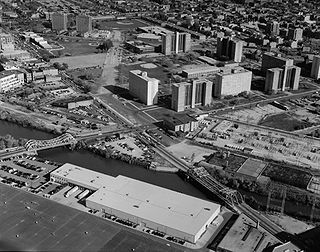
Cabrini–Green Homes was a Chicago Housing Authority (CHA) public housing project on the Near North Side of Chicago, Illinois. The Frances Cabrini Rowhouses and Extensions were south of Division Street, bordered by Larrabee Street to the west, Orleans Street to the east and Chicago Avenue to the south, with the William Green Homes to the northwest.

Robert Taylor Homes was a public housing project in the Bronzeville neighborhood on the South Side of Chicago, Illinois from 1962 to 2007. The largest housing project in the United States, it consisted of 28 virtually identical high-rises, set out in a linear plan for two miles, with the high-rises regularly configured in a horseshoe shape of three in each block. It was located along State Street between Pershing Road and 54th Street, east of the Dan Ryan Expressway. The project was named for Robert Rochon Taylor (1899–1957), an African-American activist and the first African American chairman of the Chicago Housing Authority (CHA). It was a part of the State Street Corridor which included other CHA housing projects: Stateway Gardens, Dearborn Homes, Harold Ickes Homes, and Hilliard Homes.

Oakland, located on the South Side of Chicago, Illinois, USA, is one of 77 officially designated Chicago community areas. Bordered by 35th and 43rd Streets, Cottage Grove Avenue and Lake Shore Drive, The Oakland area was constructed between 1872 and 1905. Some of Chicago's great old homes may be seen on Drexel Boulevard. The late 19th-century Monument Baptist Church on Oakwood Blvd. is modeled after Boston's Trinity Church. Oakwood /41st Street Beach in Burnham Park is at 4100 S. Lake Shore Drive. With an area of only 0.6 sq mi Oakland is the smallest community area by area in Chicago.
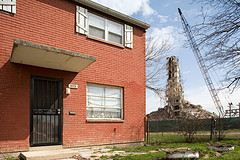
ABLA Homes was a Chicago Housing Authority (CHA) public housing development that comprised four separate public housing projects on the Near-West Side of Chicago, Illinois. The name "ABLA" was an acronym for the names of the four different housing developments that together constituted one large site: Addams, Brooks, Loomis, and Abbott, totaling 3,596 units. It spanned from Cabrini Street on the north end to 15th Street on the south end, and from Blue Island Avenue on the east end to Ashland Avenue on the west end. Most of the ABLA Homes have been demolished for the development of Roosevelt Square, a new mixed-income community by The Related Companies, with the renovated Brooks Homes being the only part left. For most of its existence, the ABLAs held more than 17,000 residents, giving it the second largest population in the CHA. It was second only to the Robert Taylor Homes and Cabrini–Green in land area and had a higher occupancy than Cabrini–Green.

Little Italy, sometimes combined with University Village into one neighborhood, is on the Near West Side of Chicago, Illinois. The current boundaries of Little Italy are Ashland Avenue on the west and Interstate 90/94 on the east, the Eisenhower Expressway on the north and Roosevelt to the south. It lies between the east side of the University of Illinois at Chicago campus in the Illinois Medical District and the west side of the University of Illinois at Chicago campus. The community was once predominantly Italian immigrants but now is made up of diverse ethnic and socio-economic backgrounds as a result of immigration, urban renewal, gentrification and the growth of the resident student and faculty population of the University of Illinois at Chicago (UIC). Its Italian-American heritage is primarily evident in the Italian-American restaurants that once lined Taylor Street. The neighborhood is home to the National Italian American Sports Hall of Fame as well as the historic Roman Catholic churches Our Lady of Pompeii, Notre Dame de Chicago, and Holy Family.

The New York City Housing Authority (NYCHA) is a public development corporation which provides public housing in New York City, and is the largest public housing authority in North America. Created in 1934 as the first agency of its kind in the United States, it aims to provide decent, affordable housing for low- and moderate-income New Yorkers throughout the five boroughs of New York City. NYCHA also administers a citywide Section 8 Leased Housing Program in rental apartments. NYCHA developments include single and double family houses, apartment units, singular floors, and shared small building units, and commonly have large income disparities with their respective surrounding neighborhood or community. These developments, particularly those including large-scale apartment buildings, are often referred to in popular culture as "projects."
HOPE VI is a program of the United States Department of Housing and Urban Development. It is intended to revitalize the most distressed public housing projects in the United States into mixed-income developments. Its philosophy is largely based on New Urbanism and the concept of defensible space.

The Housing Authority of New Orleans is a housing authority in New Orleans, Louisiana, tasked with providing housing to low-income residents.
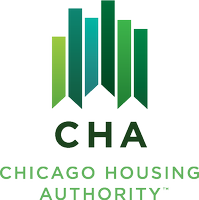
The Chicago Housing Authority (CHA) is a municipal corporation that oversees public housing within the city of Chicago. The agency's Board of Commissioners is appointed by the city's mayor, and has a budget independent from that of the city of Chicago. CHA is the largest rental landlord in Chicago, with more than 50,000 households. CHA owns over 21,000 apartments. It also oversees the administration of 37,000 Section 8 vouchers. The current acting CEO of the Chicago Housing Authority is Tracey Scott.
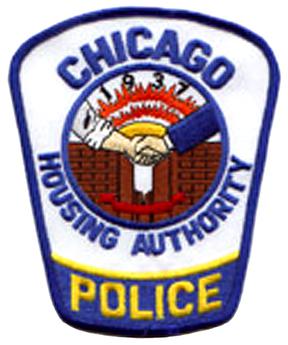
The Chicago Housing Authority Police Department (also known as the CHAPD) was created as a supplement to the Chicago Police Department (CPD), to provide dedicated police services to the residents of one of the nation's most impoverished and crime ridden developments for low-income housing. The CHAPD accomplished their daily goals by utilizing "community oriented policing techniques and aggressive vertical patrol" of all Chicago Housing Authority public housing projects throughout the inner city of Chicago, Illinois and some suburban areas.
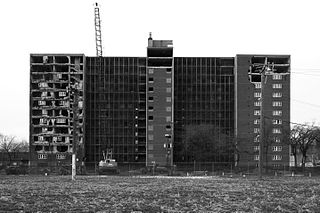
Rockwell Gardens was a Chicago Housing Authority (CHA) public housing project located in the East Garfield Park neighborhood on the Near West Side of Chicago, Illinois, United States. It was the first public housing development in the United States to be constructed using both federal and state funds. The original structures were designed by Nicol & Nicol and covered 17 acres (6.9 ha). 1,126 units of land. The second complex were located along Jackson Blvd and were standard Walk-up units in row like formations. This section is now a park as of 2014. The entire complex was located approximately 2.5 miles (4.0 km) west of the Chicago Loop, bordered by Madison Street, Van Buren Street, Western Avenue, and Rockwell Street.

Henry Horner Homes was a Chicago Housing Authority (CHA) public housing project located in the Near West Side community area on the West Side of Chicago, Illinois, United States. The original section of Henry Horner Homes was bordered by Oakley Boulevard to the west, Washington Boulevard to the south, Hermitage Avenue to the east, and Lake Street to the north near the United Center. A discontiguous section named Horner Annex was bordered by Honore Street to the west, Adams Street to the south, Wood Street to the east, and Monroe Street to the north. Constructed between 1957 and 1963, The housing project was named in honor of former Illinois governor Henry Horner.

Blueprint for Disaster: The Unraveling of Chicago Public Housing is a history of the public housing program in Chicago.

Near North Career Metropolitan High School was a public 4–year magnet high school located in the Old Town neighborhood on the Near North Side of Chicago, Illinois, United States. Operated by the Chicago Public Schools district, Near North opened in September 1979.

The Ida B. Wells Homes, which also comprised the Clarence Darrow Homes and Madden Park Homes, was a Chicago Housing Authority (CHA) public housing project located in the heart of the Bronzeville neighborhood on the South Side of Chicago, Illinois. It was bordered by 35th Street to the north, Pershing Road to the south, Cottage Grove Avenue to the east, and Martin Luther King Drive to the west. The Ida B. Wells Homes consisted of rowhouses, mid-rises, and high-rise apartment buildings, first constructed 1939 to 1941 to house African American tenants. They were closed and demolished beginning in 2002 and ending in 2011.

Dearborn Homes is a Chicago Housing Authority (CHA) public housing project located in the Bronzeville neighborhood on the South Side of Chicago, Illinois. It is located along State Street between 27th and 30th Streets, and bounded by the Metrarail line to the west. It is one of only two housing projects that still exist from the State Street Corridor which included other CHA developments: Robert Taylor Homes, Stateway Gardens, Harold Ickes Homes and Hillard Homes.

Julia C. Lathrop Homes is a Chicago Housing Authority (CHA) public housing project located along the line between the Lincoln Park and North Center neighborhoods on the north side of Chicago, Illinois, United States. It is bordered by the neighborhoods of Bucktown and Roscoe Village. Completed in 1938 by the Public Works Administration, Lathrop Homes was one of the first Chicago public housing projects. Lathrop Homes was placed on the National Register of Historic Places in 2012 and is currently undergoing restoration. Lathrop Homes consists of two-story brick row houses and three- and four-story apartment buildings separated by landscaped courtyards and linked by small archways in a campus-like arrangement. There are a total of 925 units on 35.5 acres of land.

Harold L. Ickes Homes was a Chicago Housing Authority (CHA) public housing project on the Near South Side of Chicago, Illinois, United States. It was bordered between Cermak Road to the north, 24th Place to the south, State Street to the east, and Federal Street to the west, making it part of the State Street Corridor that included other CHA properties: Robert Taylor Homes, Dearborn Homes, Stateway Gardens and Hilliard Homes.

Parkway Gardens Apartment Homes, commonly known as O-Block, is a 694-unit privately owned apartment complex located in Greater Grand Crossing area and is on the border of Woodlawn and Washington Park. Chicago's Greater Grand Crossing, Woodlawn, and Washington Park community areas are located on the South Side of Chicago, Illinois. The complex was built from 1950 to 1955; architect Henry K. Holsman, who planned several of Chicago's affordable housing developments, designed the Modernist buildings.
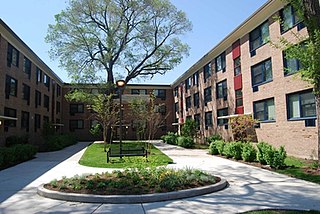
Wentworth Gardens is a low rise 344-unit housing project operated by the Chicago Housing Authority (CHA). It lies just south of Guaranteed Rate Field in Bronzeville on Chicago's south side.





















